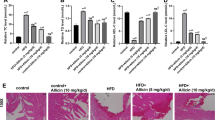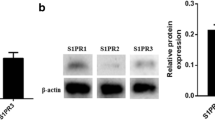Abstract
Apolipoprotein A-I (ApoA-I) mimetic peptide inhibits the development of atherosclerosis (AS) in apolipoprotein E-deficient mice; however, the underlying mechanism remains unclear. Endothelial progenitor cells (EPCs) can prevent AS progression through repairing proatherogenic factors impaired endothelium. In the present study, we examined the effect of reverse D-4F, one of apoA-I mimetic peptide on the proliferation, migration, and tube formation of mouse bone marrow-derived late EPCs. The present study showed that reverse D-4F (10–100 μg/ml) significantly improved the proliferation, migration, and tube formation of EPCs in a dose-dependent manner, and activated phospho-AKT at serine residue 473 and phospho-eNOS at serine residue 1177. LY294002 (PI3-kinase inhibitor) and L-NAME (NOS inhibitor) significantly inhibited reverse D-4F mediated improvement of EPCs biological functions, and LY294002 significantly decreased reverse D-4F stimulated activation of phospho-AKT (473) and phospho-eNOS (1177). The results indicate that reverse D-4F mediated improvement of EPCs functions is dependent on the PI3K/AKT/eNOS pathway.





Similar content being viewed by others
References
Morgantini C, Imaizumi S, Grijalva V, Navab M, Fogelman AM, Reddy ST (2010) Apolipoprotein A-I mimetic peptides prevent atherosclerosis development and reduce plaque inflammation in a murine model of diabetes. Diabetes 59(12):3223–3228
Navab M, Anantharamaiah GM, Reddy ST, Hama S, Hough G, Grijalva VR, Wagner AC, Frank JS, Datta G, Garber D, Fogelman AM (2004) Oral D-4F causes formation of pre-beta high-density lipoprotein and improves high-density lipoprotein-mediated cholesterol efflux and reverse cholesterol transport from macrophages in apolipoprotein E-null mice. Circulation 109(25):3215–3220
Van Lenten BJ, Wagner AC, Jung CL, Ruchala P, Waring AJ, Lehrer RI, Watson AD, Hama S, Navab M, Anantharamaiah GM, Fogelman AM (2008) Anti-inflammatory apoA-I-mimetic peptides bind oxidized lipids with much higher affinity than human apoA-I. J Lipid Res 49(11):2302–2311
Peterson SJ, Husney D, Kruger AL, Olszanecki R, Ricci F, Rodella LF, Stacchiotti A, Rezzani R, McClung JA, Aronow WS, Ikehara S, Abraham NG (2007) Long-term treatment with the apolipoprotein A1 mimetic peptide increases antioxidants and vascular repair in type I diabetic rats. J Pharmacol Exp Ther 322(2):514–520
Zhang Z, Qun J, Cao C, Wang J, Li W, Wu Y, Du L, Zhao P, Gong K (2011) Apolipoprotein A-I mimetic peptide D-4F promotes human endothelial progenitor cell proliferation, migration, adhesion though eNOS/NO pathway. Mol Biol Rep 39(4):4445–4454
Qin S, Kamanna VS, Lai JH, Liu T, Ganji SH, Zhang L, Bachovchin WW, Kashyap ML (2012) Reverse D4F, an apolipoprotein-AI mimetic peptide, inhibits atherosclerosis in ApoE-null mice. J Cardiovasc Pharmacol Ther 17(3):334–343
Chiang CH, Huang PH, Chung FP, Chen ZY, Leu HB, Huang CC, Wu TC, Chen JW, Lin SJ (2012) Decreased circulating endothelial progenitor cell levels and function in patients with nonalcoholic fatty liver disease. PLoS ONE 7(2):e31799
Cacciatore F, Bruzzese G, Vitale DF, Liguori A, de Nigris F, Fiorito C, Infante T, Donatelli F, Minucci PB, Ignarro LJ, Napoli C (2011) Effects of ACE inhibition on circulating endothelial progenitor cells, vascular damage, and oxidative stress in hypertensive patients. Eur J Clin Pharmacol 67(9):877–883
Callaghan MJ, Ceradini DJ, Gurtner GC (2005) Hyperglycemia-induced reactive oxygen species and impaired endothelial progenitor cell function. Antioxid Redox Signal 7(11–12):1476–1482
Di Stefano R, Barsotti MC, Felice F, Magera A, Lekakis J, Leone A, Balbarini A (2010) Smoking and endothelial progenitor cells: a revision of literature. Curr Pharm Des 16(23):2559–2566
Yang L, Guan H, He J, Zeng L, Yuan Z, Xu M, Zhang W, Wu X, Guan J (2012) VEGF increases the proliferative capacity and eNOS/NO levels of endothelial progenitor cells through the calcineurin/NFAT signalling pathway. Cell Biol Int 36(1):21–27
Shen L, Gao Y, Qian J, Wu Y, Zhou M, Sun A, Zou Y, Ge J (2012) The role of SDF-1α/Rac pathway in the regulation of endothelial progenitor cell polarity; homing and expression of Rac1, Rac2 during endothelial repair. Mol Cell Biochem 365(1–2):1–7
Smadja DM, Laurendeau I, Avignon C, Vidaud M, Aiach M, Gaussem P (2006) The angiopoietin pathway is modulated by PAR-1 activation on human endothelial progenitor cells. J Thromb Haemost 4(9):2051–2058
Ioka T, Tsuruoka S, Ito C, Iwaguro H, Asahara T, Fujimura A, Kusano E (2009) Hypertension induced by erythropoietin has a correlation with truncated erythropoietin receptor mRNA in endothelial progenitor cells of hemodialysis patients. Clin Pharmacol Ther 86(2):154–159
Lavi R, Zhu XY, Chade AR, Lin J, Lerman A, Lerman LO (2010) Simvastatin decreases endothelial progenitor cell apoptosis in the kidney of hypertensive hypercholesterolemic pigs. Arterioscler Thromb Vasc Biol 30(5):976–983
Thum T, Hoeber S, Froese S, Klink I, Stichtenoth DO, Galuppo P, Jakob M, Tsikas D, Anker SD, Poole-Wilson PA, Borlak J, Ertl G, Bauersachs J (2007) Age-dependent impairment of endothelial progenitor cells is corrected by growth-hormone-mediated increase of insulin-like growth-factor-1. Circ Res 100(3):434–443
Zhu G, Song M, Wang H, Zhao G, Yu Z, Yin Y, Zhao X, Huang L (2009) Young environment reverses the declined activity of aged rat-derived endothelial progenitor cells: involvement of the phosphatidylinositol 3-kinase/Akt signaling pathway. Ann Vasc Surg 23(4):519–534
Yin T, Ma X, Zhao L, Cheng K, Wang H (2008) Angiotensin II promotes NO production, inhibits apoptosis and enhances adhesion potential of bone marrow-derived endothelial progenitor cells. Cell Res 18:792–799
Asahara T, Murohara T, Sullivan A, Silver M, van der Zee R, Li T, Witzenbichler B, Schatteman G, Isner JM (1997) Isolation of putative progenitor endothelial cells for angiogenesis. Science 275(5302):964–967
Schatteman GC (2004) Adult bone marrow-derived hemangioblasts, endothelial cell progenitors, and EPCs. Curr Top Dev Biol 64:141–180
Fadini GP, Losordo D, Dimmeler S (2012) Critical reevaluation of endothelial progenitor cell phenotypes for therapeutic and diagnostic use. Circ Res 110(4):624–637
Huang PH, Chen YH, Chen YL, Wu TC, Chen JW, Lin SJ (2007) Vascular endothelial function and circulating endothelial progenitor cells in patients with cardiac syndrome X. Heart 93(9):1064–1070
Pu DR, Liu L (2008) HDL slowing down endothelial progenitor cells senescence: a novel anti-atherogenic property of HDL. Med Hypotheses 70(2):338–342
Tso C, Martinic G, Fan WH, Rogers C, Rye KA, Barter PJ (2006) High-density lipoproteins enhance progenitor-mediated endothelium repair in mice. Arterioscler Thromb Vasc Biol 26(5):1144–1149
Predmore BL, Julian D, Cardounel AJ (2011) Hydrogen sulfide increases nitric oxide production from endothelial cells by an akt-dependent mechanism. Front Physiol 2:104
Choi HE, Yoo MS, Choi JH, Lee JY, Kim JH, Kim JH, Lee JK, Kim GI, Park Y, Chi YH, Paik SH, Lee JH, Lee KT (2011) BRN-103, a novel nicotinamide derivative, inhibits VEGF-induced angiogenesis and proliferation in human umbilical vein endothelial cells. Bioorg Med Chem Lett 21(21):6236–6241
Presta I, Tassone EJ, Andreozzi F, Perticone M, Sciacqua A, Laino I, Musca D, Martino F, Sesti G, Perticone F (2011) Angiotensin II type 1 receptor, but no type 2 receptor, interferes with the insulin-induced nitric oxide production in HUVECs. Atherosclerosis 219(2):463–467
Florian M, Lu Y, Angle M, Magder S (2004) Estrogen induced changes in Akt-dependent activation of endothelial nitric oxide synthase and vasodilation. Steroids 69(10):637–645
Acknowledgments
This study was supported by the National Natural Science Foundation of China (No. 30971098), the Province Natural Science Foundation of Shandong (No.Z2008C03), the Province Natural Science Foundation of Shandong (No.ZR2012HL18), Taishan Scholars Project Funding from Shandong Province, Natural Science Foundation of Taishan Medical University (2011ZR004), and Province Chinese Medicine Science and Technology Development Project of Shandong (2011-228).
Author information
Authors and Affiliations
Corresponding author
Additional information
Nana Yang and Shutong Yao equally contributed to this study.
Rights and permissions
About this article
Cite this article
Yang, N., Yao, S., Wang, M. et al. Apolipoprotein A-I mimetic peptide reverse D-4F improves the biological functions of mouse bone marrow-derived late EPCs via PI3K/AKT/eNOS pathway. Mol Cell Biochem 377, 229–236 (2013). https://doi.org/10.1007/s11010-013-1592-z
Received:
Accepted:
Published:
Issue Date:
DOI: https://doi.org/10.1007/s11010-013-1592-z




